Workation » Best Workation Locations and Why You Should Visit Them » Croatia » 10 Unesco World Heritage Sites to Visit in Croatia on Workation
10 Unesco World Heritage Sites In Croatia to Visit on Workation
Unesco World Heritage Sites demonstrate a rich connection to culture, history, and natural beauty you can explore on a Workation in Croatia. The small borders and population defy the grand connection to World Heritage with a number of listed sites and many more possibilities.
Each Unesco site in Croatia demonstrates another marvel of the country with connections to ancient Rome, medieval strongholds, natural wonders, and episodic grandeur that speaks to its popularity as a filming destination. Waterfalls, defensive walls, and elegant palatial facades enhance the atmosphere and add to Croatia’s unique allure unlike anywhere else in the world.
A destination listed as a Unesco site protects, preserves, and identifies the important heritage of the location, making it accessible to locals and international travelers interested in visiting. Visit during the summer peak or explore each site in the off-season cool of winter, with each season adding its own reasons to enjoy an exciting new perspective of the country.
Plitvice Lakes National Park
What is Plitvice Lakes National Park?
Plitvice Lakes National Park is the oldest and largest national park in the country and covers over 74,131 acres. That’s nearly 116 square miles. The park consists of an exceptional collection of 16 turquoise lakes that spill over into rows of terraced waterfalls. The park is famous for its beauty and unique combination of trails that can give visitors access to panoramic views. The park gained international recognition in 1979 when it was granted Unesco status.
Why Visit?
Everyone’s reason to visit Plitvice Lakes National Park is individual, with more than one million people annually visiting from around the world. Visiting could be to check off a bucket list item, to look good for a social media post, or be part of a milling crowd in summer, but mainly visitors come to Plitvice National Park to really experience Croatia’s natural beauty at its finest.
The Dalmatian coast and islands have great beaches and coves, the Istrian peninsula has charming rolling hills and vineyards, but Plitvice Lakes National Park sparkles with personality. It smells like wet bark and cypress, the trickling sound of the waterfalls never feels far away, and beyond the cascades, you can find wildlife like shrews, hedgehogs, and Eurasian brown bears.
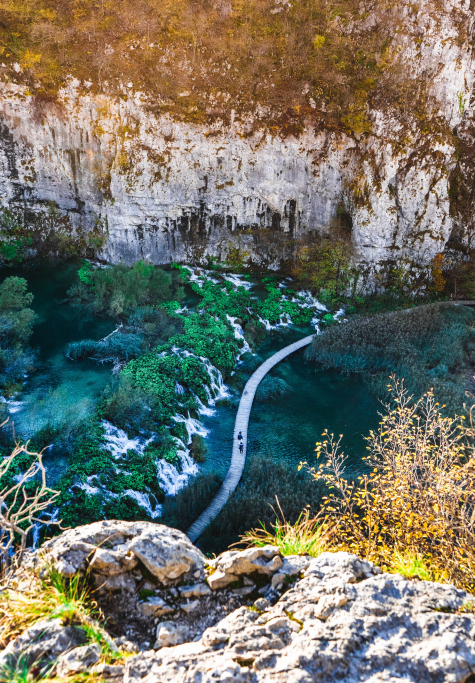

Diocletian’s Palace, Split
What is Diocletian’s Palace?
Diocletian’s Palace in Split is often referred to as one of the best-preserved Roman ruins in the world. Built for the Roman Emperor Diocletian in the 4th century CE, the palace is more of a massive complex that still withholds and protects contemporary life in the city. The original structure was not just housing for royalty but also a building meant for housing the military garrison resulting in a foundation spanning more than 322,917 square feet. It became an Unesco World Heritage site in 1979 and continues to host one of the world’s oldest cathedrals, The Cathedral of St. Domnius.
Why Visit?
Visiting Diocletian’s Palace when in Split is less than a question and more of a command. The enticing and massive structure stands as the heart of Old Town and hosts numerous shops, cafes, and restaurants making it a lively center for life day and night nearly 2,000 years after its construction. Approximately 3,000 people continue to live on the grounds of the palace.
When visiting the cobblestone streets of Old Town, you won’t feel like you’re walking through a palace and instead may only notice the ancient construction around you as an architectural detail that adds to the buzz of contemporary city life. You can also discover more history inside the cathedral by visiting the mausoleum of Emperor Diocletian himself.

Old Town, Dubrovnik
What is the Old Town in Dubrovnik?
Old Town in Dubrovnik is an immersion into a preserved medieval city surrounded by the original defensive walls. The ramparts are over a mile long and have helped keep the interior of the antique streets and houses intact, protected from invaders on both land and sea for centuries.
The city flourished as a center for maritime trade between the 15th and 16th centuries resulting in wealthy locals and an influx of cash used to build impressive structures beyond the city walls that have withstood the test of time. Old Town was granted Unesco World Heritage status in 1979 and even with the crowded summers, continues to showcase Croatian culture and a deep connection to local heritage.
Why Visit?
Old Town’s beauty has only enhanced its reputation as it garnered the name “The Pearl of the Adriatic.” A large collection of Gothic churches and Renaissance palaces offer an impressive view from the street but the contrast between the sloping orange-tiled rooftops and turquoise sea offers a much grander panorama. The unique layers of history preserved and restored across the town is one of the reasons why Dubrovnik is often used at a filming site for historical or fantastical stories, including the TV series Game of Thrones and its prequel House of Dragons.
St. James Cathedral, Sibenik
What is St. James Cathedral?
St. James Cathedral in Sibenik is considered a marvel of architectural design and engineering. It took more than a century to complete and remains a unique entity because it was constructed entirely of stone. St. James Cathedral became an Unesco protected site in the year 2000 but has been a celebrated tourist attraction in addition to remaining a local house of worship since its creation.
A variety of architectural styles adds to the distinct features that have attracted visitors from around the world. Its cathedral has a central importance to Sibenik, adds proportion to the skyline, and also provides insight into the combination of Dalmatian and Italian Renaissance design.
Why Visit?
St. James Cathedral has become near legend with its beauty emphasized by the imposing Renaissance dome. The dome itself has become a symbol of the city and beyond the illustrious construction, artistic elements around the cathedral shape a stunning atmosphere. 71 sculptures of heads decorate a shrine in the apse.
It is unclear who the faces represent but common knowledge expects that each statue reflects a local townsperson featuring men, women, and children. Their facial expressions have also been frozen in time adding to the mystery and mystique of the structure.
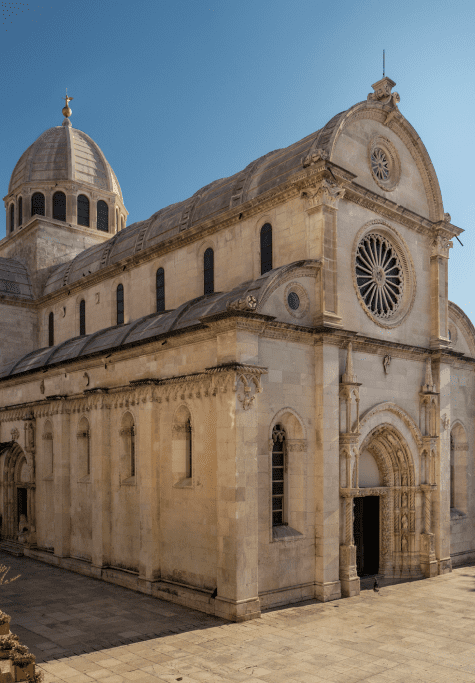

Stari Grad Plain, Hvar
What is Stari Grad Plain?
In 2008, Stari Grad Plain joined Unesco as a world heritage site providing one of the best examples of preserved ancient Greek agricultural systems in the country. Since the 4th century BCE, the Star Grad Plain has grown grapes and olives, which are still being produced in the same way.
Beyond the crops still being cultivated, the plain maintains the system of cultivation with parcels separated by dry stone walls. This system helped divide both the crops and irrigation needed to produce the crops. More than just Greek history, the plain also offers glimpses into Roman and Venetian colonization on the island.
Why Visit?
The plain is an overlooked gem of cultural heritage connecting the past and present with tangible action. Visiting the Stari Grad Plain is about discovering the irrigation system used over two millennia ago and finding how the systems continue to work for local cultivation. Quieter, more relaxing, and a unique peek into the fabulous history of the island and greater Croatia, Stari Grad Plain is a cultural and scenic marvel.
Episcopal Complex, Porec
What is the Episcopal Complex?
The Episcopal Complex in Porec is a grand experience in a small town. Added to the Unesco list in 1997, the basilica, sacristy, baptistery, and bell tower provide a rare vision of Byzantine architecture in the world with foundations dating back to the 4th century BCE. The complex is complete and has survived the toppling of governments, civilizations, and empires with preserved elements that speak to the greater perspective of the times. Gold mosaics capture the typical style of artistic form but provide a more ethereal atmosphere with candlelight spread throughout the different buildings in the complex giving it a unique touch unlike anywhere else in the country.
Why Visit?
History is rich and lively in the Episcopal Complex in Porec. The complex itself is believed to be one of Christianity’s founding centers coupling its architecture marvels with its religious significance.
The collaboration between Byzantine and Christian iconography results in the fantastic mosaics from the time period that have survived nearly two millennia with the city of Porec growing around the complex’s towering structures. Looking closely at the mosaics, you can see history captured in the artwork with icons clothed in Roman dress or featured with halos circling their heads.

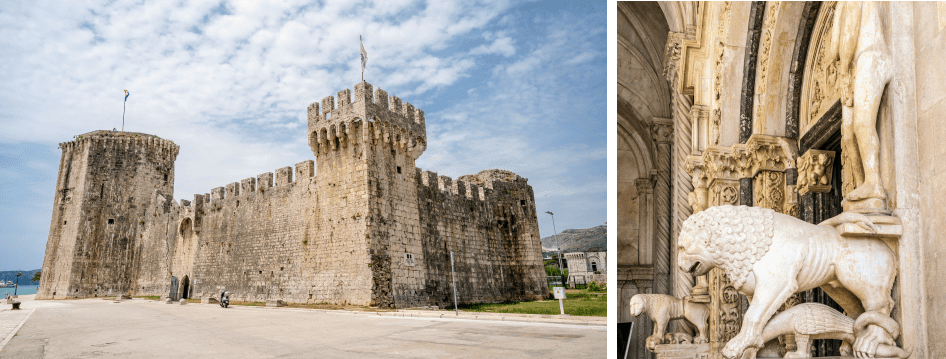
Historic Trogir
What is Historic Trogir?
Trogir is less than 20 miles away from Split but offers another ancient world to explore. The historic center joined Unesco in 1997 circling around the Cathedral of St. Lawrence and its Romanesque style.
The Kamerlengo Fortress lines the waterfront and reflects the beauty of the 15th century during the rule of the Venetian Republic. Touches of Roman-Gothic design add to the preservation of the city and its cultural value featured in the palaces, churches, and along the cobblestone streets. The city itself dates back to the colonization of the ancient Greeks in the 4th century BCE leading to medieval, Renaissance, and Gothic designs spreading from the inland streets to the waterfront.
Why Visit?
The beauty of Trogir is its magic and reason for visiting. Renaissance palaces, Romanesque churches, architectural gems, and the Venetian-era facades that offset the calm water, the elements of the city feature the connection between cultural heritage and scenic charm.
The Cathedral of St. Lawrence is a great example of the combined architectural styles with elements dating back to the late 12th century BCE. Visiting Trogir is much more than just its history, with each new street opening up to views of the attractive waterfront or setting visitors beneath the elegant skyline.

Defenses of Zadar, Zadar
What are the Defenses of Zadar?
Zadar’s Defensive System is a 15th-century CE Venetian fortress used to solidify the importance of Zadar as an important administrative center for the Republic’s navy and empire outside of the main city. The prime position on the Adriatic made Zadar a great center for trade and a strategic post for fighting the Ottomans.
The defenses demonstrate the wealth of the empire and the intricate details the architects used for showing that wealth in artistic action with ornate gates, dramatic bastions, and city walls that were once innovative. The preserved system was added to the Unesco list in 2017 and, centuries after the Republic’s crumbling, expanded its artistic influence through its preserved fortifications.
Why Visit?
The Defenses at Zadar help visitors truly understand the might and power of the Venetian Republic nearly half a millennia ago. When exploring the walls, buildings, and adornments, it is easy to imagine standing out looking at distant enemies or looking onward as an invader trying to grasp how to enter the fold. Imposing, yet elegant, majestic, yet strategic, the defenses are a testament to maritime war, historic tactics, and the importance of Zadar as a strategic location at the height of the Republic.
St. Nicholas Fortress, Sibenik
What is St. Nicholas Fortress?
The triangular fortress was constructed in the 15th century CE by the Venetian Republic after a devastating attack on Sibenik by Ottoman forces. What had decimated the importance of salt production at the time caused the empire to reconsider its defenses around the bay resulting in the unique triangulate design completed in the mid 16th century.
The imposing defenses kept the town safe and the salt pans untouchable maritime attacks. The fortress is the only one of its kind ever built under the reign of the Venetian Republic and was added to the Unesco list in 2017.
Why Visit?
Restoration and conservation works have brought the fortress back to life. The unique stand-alone position of the defensive system requires a boat to reach the entrance after sailing through St. Anthony’s Channel.
The journey to the fortress is a thrill on its own but the breathtaking panorama of the island allows visitors to experience how large the structure actually is and how much it dominates the bay. The first impression is of a strong, impregnable defensive system but once on the island, the typical Venetian flourishes become visible as well, such as the elaborate gates or elegant trim, vaulted interiors and strategic gun ports.

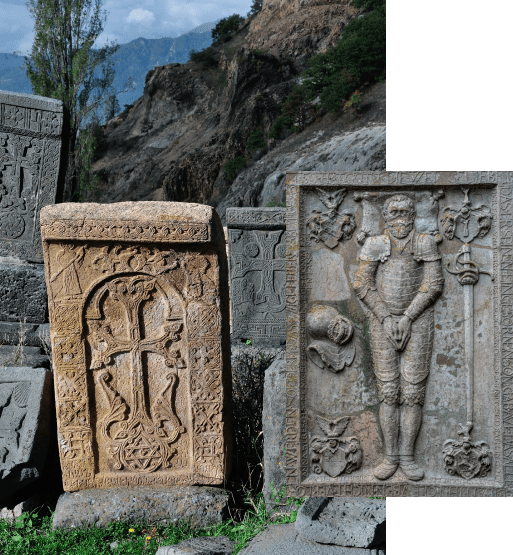
Medieval Tombstone Graveyards, Cista Velika and Konavle
What are the Medieval Tombstone Graveyards?
Stecci refers to the medieval tombstone graveyards spread across Central European countries like Serbia, Montenegro, Bosnia and Herzegovina, and Croatia. The protected monuments date to between the 12th and 15th centuries with the majority of the stones engraved in the old Bosnian Cryllic alphabet.
However, the necropolises at Cista Velika and Konavle have stones etched with Glagolitic script, an alphabet based on Greek minuscule but used in early slavic-based languages. The tombstones are primarily carved from limestone and feature decorative motifs typical of medieval times in the area made further unique by the language used on a number of stones. The stecci were welcomed onto the Unesco list in 2016 protecting all 28 sites across the different countries.
Why Visit?
The stecci are an important part of Balkan history unique to this part of the world and references a culture and heritage from nearly 1,000 years ago. Three faiths converge in the graveyards depicted on the stones that include Orthodox, Catholic, and the Bosnia church further highlighted by the sheer volume of stones present, which reaches approximately 70,000 across Europe. No matter their presence in other countries around the Balkan area, they are an inherent and indelible part of Croatia’s heritage and culture, a demonstration of art and familial connection that spans nearly a millennium.
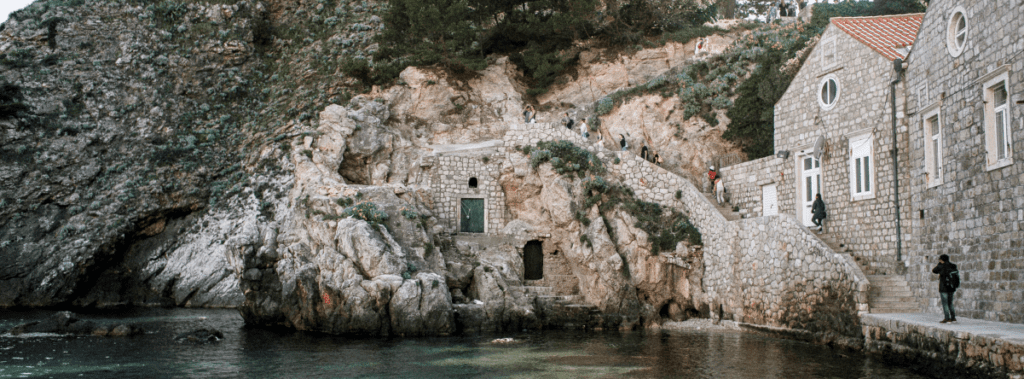
Visit Unesco World Heritage Sites on Your Workation
Unesco World Heritage sites in Croatia each tell their own story, no matter where you visit. Time spent among the natural beauty or cultural wonders can unveil the intrinsic connection Croatians have with ancient architecture and preserved landscapes, continuing to enjoy what the past has created in new and exciting ways. Walk trails, sit in a cafe set in an ancient palace, or wander amongst the medieval headstones while focusing on your best way to balance work and life your way.
Find more information on what you can do and where you can visit to guide your expectations before speaking with Workation to plan your Croatia visit. When you are ready, allow us to enhance your productivity and accentuate your connection with our understanding of the local life and culture that you want to experience. Take one step closer to planning your Workation or find more information with our ideas of The Best Walkable Cities in Croatia.

